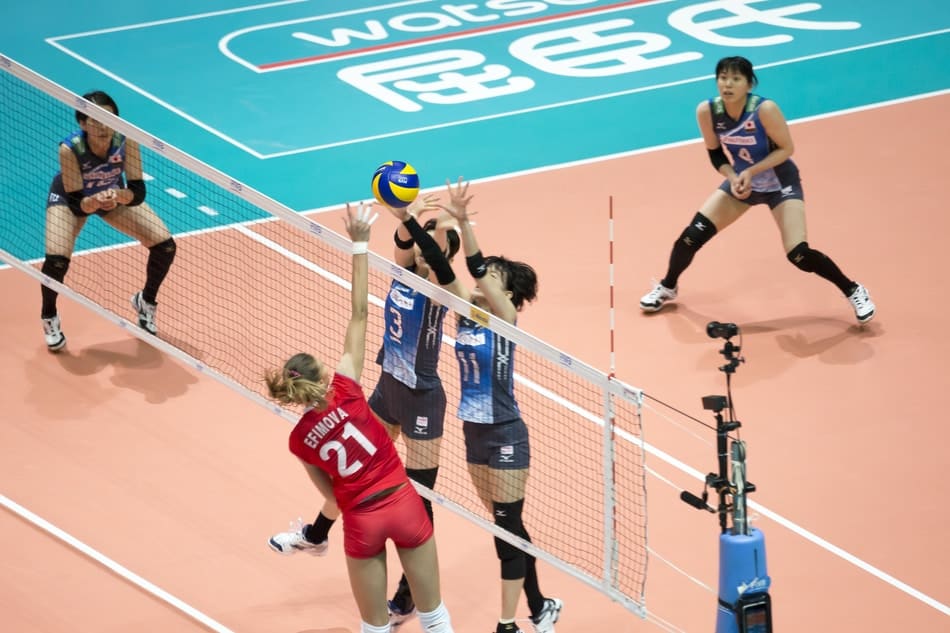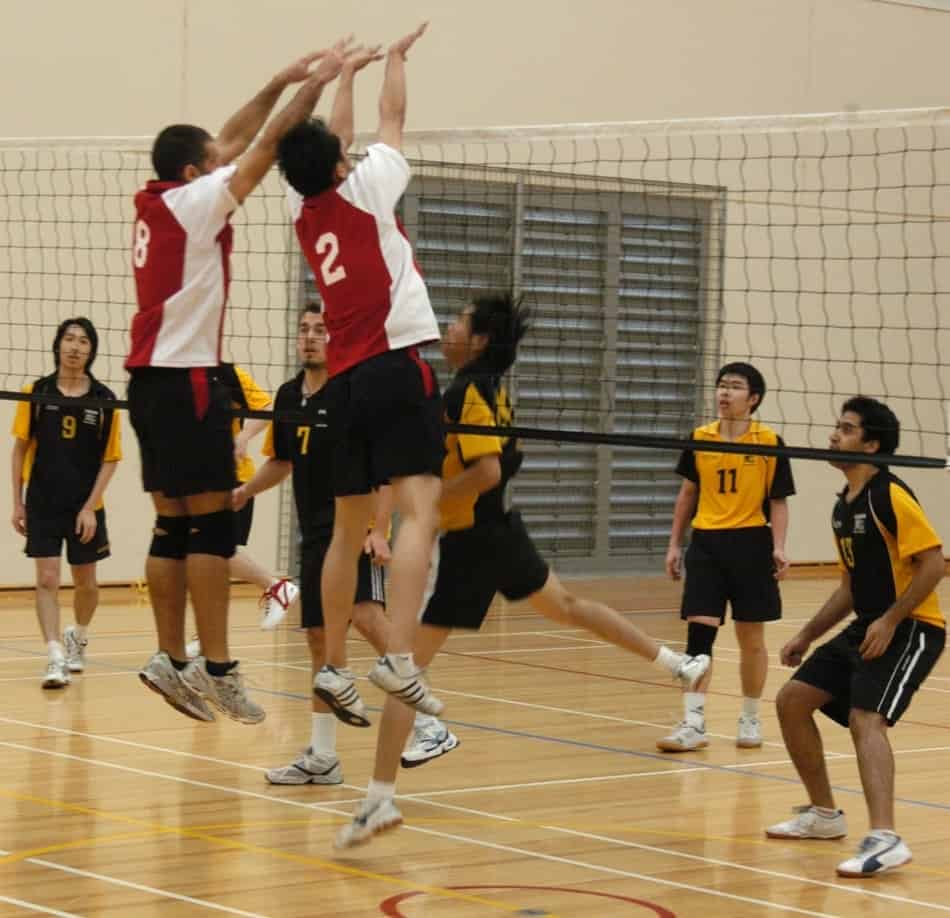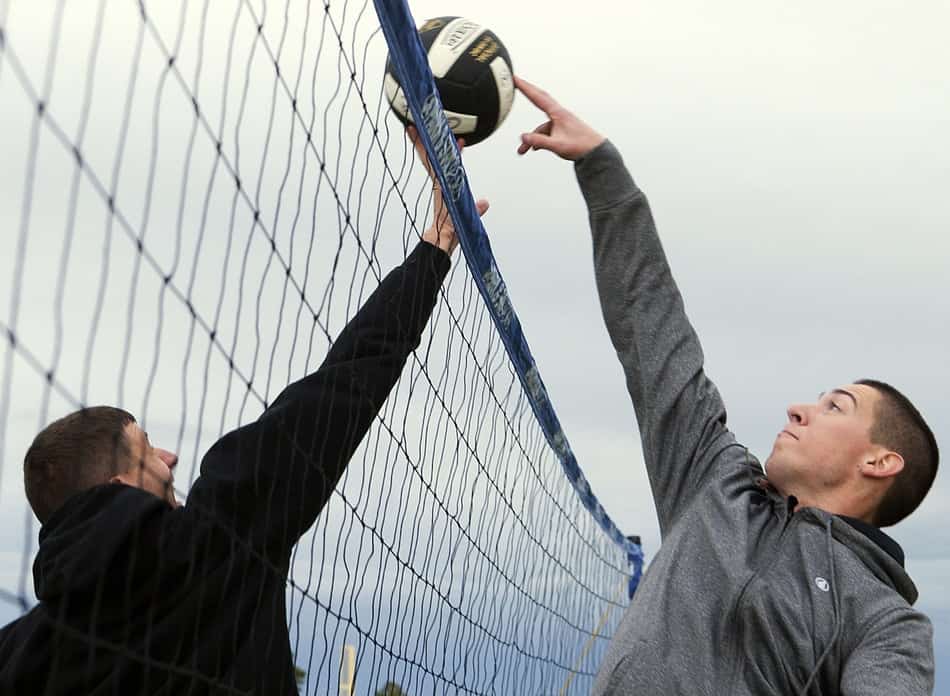If you are new to volleyball or looking to improve your knowledge of the sport, dedicate some time to understanding all the different terms, positions, and plays to expect in the game. Whether you are playing volleyball recreationally or competitively, it’s very important to have a good understanding of blocking.
What are the different types of blocking in volleyball? There are 3 types of volleyball blocks when you’re referring to the number of people: a single block, a double block, and a triple block. Then there are different types based on technique: blocking line, blocking cross-court, soft blocking and swing blocking.

What Does A Blocker Do?
In volleyball, blocking is when you deflect the ball delivered from the opposing team’s attacking hit. The main responsibility of a blocker is to block the ball back into the opposing team’s court. Think of it as playing goalie in soccer or hockey, you’re trying to keep the ball out by guarding your zone!
Effective volleyball blocking takes strategy and speed. In this article, you can learn about the different types of blocks, the different blocking positions, terms that have to do with blocking and how to improve your skills in the art.
Only players that are on the front row will be involved in blocking. Players on the back row in the rotation are not allowed to contact the ball above the height of the net, so blocking won’t be possible. When you block, you’re reaching above and over the net, to try to intercept the ball before it can come across onto your side.
Your goal in blocking is to deflect the ball back down on to your opponent’s side of the court. If that’s not possible, you at least want to create a wall or space that your backcourt defense can use to judge where the ball will not be hit, which helps them know where to protect. This becomes much more successful when you can work together with your teammates to double or triple block and form a wall.
Types of Blocks by Number of Players
Single blocking:
While not the most effective type of blocking, a single block allows the back row to dig or pass more easily and prevents a free kill. When you’re playing against tough competition, your team may be scattered and scrambling and this may be the only kind of blocking you can do on many plays. When your opposition is running multiple hitters on approach, you may have to divide and each be ready to single block if necessary.
Double blocking:
Two blockers focus attention on the opposition’s hitter to deflect an attacked ball at the net. Whoever the player is closest to being in front of the attacker becomes the primary blocker. The teammate next to them needs to come in and assist by lining up as closely as possible to create a wall.

Triple blocking:
With more hands available to deflect the ball and deter the play, triple blocking is the most effective type. All three front row players jump in unison to create this triple block. This really becomes the goal when you’re facing a dominant hitter that you need to shut down. If you can mount a solid wall, the hitter will be forced to play around or over it which will give your back row a much easier ball to defend.
This is usually going to happen near the middle of the net because your middle blocker will need to be your primary blocker. They will line up and each of the outside hitters will close the gap on each side.
Catch Opposition Hitters Unaware with Alternative Blocking Strategies
A large part of the blocking role is surprising the opposition hitters with unpredictable blocking techniques and strategies. You should have a few of these perfected and “in reserve” just in case you find yourself faced with strong hitters and a blocking defense that seems to be failing. Consider these alternative volleyball blocking strategies:
Soft Blocking Strategy
Soft blocking is a form of blocking the ball just enough to keep it in play. It is very effective when you find yourself playing against a big hitter that keeps hitting the volleyball over you or if the blockers are short.
How to soft block: reach high and backward when blocking the ball. The objective is to deflect the ball in such a way that it deflects the ball upwards so that your teammates can make a play.
Something to keep in mind: soft blocking is not an official block and may be considered your volleyball team’s first contact with the ball. After this, your team can only contact the ball 2 more times before sending it over the net.
Split Blocking Strategy
If you are dealing with a hitter that consistently hits the volleyball around the block sharply, you may want to disarm and switch things up. A great way to take an opposing hitter by surprise is by split blocking.
Split blocking is not something that happens spur of the moment without any prior planning. You will need to strategize with your teammates ahead of time. This type of blocking requires the Outside Side or Strong Side Blocker to take the line while the Middle Blocker takes the angle hit.
Swing Blocking
The term swing blocking covers multiple ideas:
1. Swing blocking is a modified jumping technique that uses forward stepping across the horizontal space of the net, planting your inside foot, a twisting step, combined with a swinging arm motion to generate more thrust upwards and a lunging arm motion that penetrates over the net toward the ball.
2. Swing blocking also describes how the middle is moving to either side to assist the outside blocker. The idea is that they swing to whichever side needs help on that particular play, usually using the movement described above in #1.
Swing blocking takes better body control than a standard block, but with the right players, it may produce more consistent penetration into your opponent’s air space.
Solo Blocking Strategy
If you’re the only player going up to block, that’s a solo block. When you are blocking alone, you will have to decide if you are “blocking line” or “blocking angle”. The line shot means they are aiming to hit it down the sideline, while the angle shot is hitting it towards the center of the court.
By choosing one or the other, you’re shutting down one of their options. Often, you’ll be able to guess right and you’ll make a great block. When you misjudge them and guess wrong, your defense can still try to read where you were going and cover the opposite to pick it up with a nice dig.
Solo blocking is also mainly how you will block a back-row attack. When you see the opposing setter put it up for their back row, you can usually solo block and your teammates can help cover wide or get ready for their attack.
Volleyball Blocking Positions and Terms
There are all kinds of blocking terms and concepts in volleyball. These are the most common other terms that are used to describe positions, strategies, statistics, and concepts you need to understand.
Weak Side Blocker
The blocker that plays on the left of the court is called a Weak Side Blocker. Any attacks played on the left of the court should be blocked or deflected by this particular blocker.
Middle Blocker
The blocker covering the space in the middle of the net is called a Middle Blocker. This blocker takes on a lot of pressure as they must essentially protect the net nearly all the way across. Middle Blockers are often the tallest players on the court and must be quick on their feet.
Strong Side Blocker
While the Weak Side Blocker protects the left side of the court, the Strong Side Blocker protects the right side. Most teams’ strongest hitters will be playing on the left side of their court and so we have to put our strongest and most effective blocker against them on our right-hand side.
Offside Blocker
This can be the blocker on either side of the net, it just depends where the opponent is attacking. So whichever side is not being attacked becomes the “offside.” When you are the offside blocker your duty is to backup your teammates covering for tips or transition early to make a quick attack when you’re set up.
A Block Assist
A block assist is a statistic that will be awarded to any player who combines for a block. If you team up with another player (or two) and either of you blocks the ball, each of the players working together is given a “block assist”. This is also sometimes called a collective block.
Sealing or Closing The Block
Whenever a block is being made, there is a primary blocker. This would be whoever is the main player responsible for covering this part of the net. Whoever can come in and assist the main blocker needs to try to close the gap to form a wall.
Closing or sealing the block is critical because you don’t want to let the ball slip through your hands. Your back row defenders are counting on you and your fellow blockers to defend that part of the net, so they won’t be ready to make a good pass if you let that ball between you.
A Stuff Block
A stuff block is incredibly satisfying as a defender! It’s when you line up that ball just right and deflect it back at your opponent or their floor just as hard as they hit it. Whether you bounce it off their face, their body or the floor in the general area, if you got a good clean ricochet, that’s a stuff block.
A Tip or Dink
A tip is when an attacker doesn’t strike the ball full-force, but instead, they use a “touch” shot to place the ball somewhere you may not be expecting or defending. In beach volleyball, the attacker would use their knuckles instead of an open hand and this would be called a dink.
These can be very hard to defend because you’re used to blocking a high-speed ball, but they may barely tap it to the side or just above your hands. Advanced blockers will know to watch the attacker’s hitting arm all the way through their approach to try to pick up information as early as possible if the attacker decides to tip instead of deciding to spike.
To learn all the different volleyball lingo, check out this post about volleyball terms, abbreviations, acronyms, and statistics.
A Joust
When a player from each side of the net hit the ball at exactly the same time, that’s called a joust. It usually feels pretty awkward and whoever has the most momentum usually ends up being able to force their will on the ball.

As soon as you realize this is about to happen, be intentional about trying to make a hard push with your fingers and wrists to push the ball to a target spot. Your opponent will usually be just stretching to touch the ball if you are pushing to a specific direction that can force an angle in your favor.
Tips for blockers:
- You have to stay close to the net and on high alert.
- Your palms should be facing the net at shoulder height, elbows bent, hands in, in front of your face, but not blocking your vision.
- If the setter jump sets, do not jump with her, watch her body to know where she is sending the ball and prepare for your block.
- Watch which hitter the ball is set to and then focus your attention on that hitter.
- You need to work on your skills at reading other people. If you are able to read the opposing team’s hitters well, it will make defense a lot easier.
- Pay attention to your hands in the air. You want to pinch your shoulders in when you jump, then press your hands with your thumbs up making your hands big. You want to spread your fingers to cover a wide space while keeping your hands close to not leave gaps for the ball to pass through.
- As you stretch to reach your hands over the net, be careful not to touch it.
- Avoid connecting with the ball in a way that sends it off the court or into your side of the court. If you block the ball out of bounds on either side of the court, you lose the point. By angling your hands to face towards the middle of their court (this will take practice), you can ensure that the ball rebounds off your hands and is delivered into the opposing side’s court.
- As soon as you have connected with the ball (and even if you have not), make sure that you know exactly where the ball is at all times of play. You cannot block the ball if you don’t know where it is.
- When you are blocking the outsides, whoever is blocking the outside of the court, a good strategy is to line up with the hitter’s arm. You are defending the cross-court (or angle) attack, which is defending the majority of the court. This is inviting the hitter to attack the line, which is a specific narrow lane that your libero or defensive specialist can more easily defend.
- Only jump after the attacker from the opposing team jumps. If you jump before or even at the same time, you will be too early and you’ll be coming down when the ball is crossing the net. This is all about timing so be ready and be quick.
- When you’re assisting to form a double or triple block, make sure you’re jumping in unison. This is critical!
If you would like to learn more about blocking, check out our article called: Six Steps To Dominate In Volleyball With Incredible Blocking.
A Note of Caution While Blocking
While we always want to be aggressive and bring the fight to our opponents, when you’re blocking you have to play by the rules. The rules say that you can’t impede your opponent’s ability to hit an attack against you. Meaning you can’t block the ball before the hitter has a chance to strike it.
This sounds crazy the first time you hear it, but it’s true. In the spirit of fair play, the rules limit you to playing defense with your block. So if your opponents set the ball, it’s on the way to the hitter and you reach over and block the ball before their hitter can strike it, the referee should call you for interference and award the other team the point.
Blocking Styles and Strategies
With different blocking positions and styles dominating the game of volleyball, it is obvious that practice and strategic planning are important. Blocking is not only used to defend the team from attacks, but also to throw the opposing team off and manipulate where they hit the ball. the above tips and strategies to hone your skills and drive your volleyball team to more wins.
Photo Credits:
Feature image by Eric Guo on flickr.com: https://creativecommons.org/licenses/by/2.0/
Blocking player #21 image by Jeffrey Ng on flickr.com: https://creativecommons.org/licenses/by-sa/2.0/
Double blocking image by Hunter Nield on flickr.com: https://creativecommons.org/licenses/by-sa/2.0/
Joust image by Richard Oriez on flickr.com: https://creativecommons.org/publicdomain/mark/1.0/
Recent Posts
Athletes, listen up! Do you have a closet full of old jerseys, sweatpants, and tees that you just can't seem to part with? Well, dust them off, because you're sitting on a goldmine of fashion...
You may have heard, or you may have noticed, that there's been a change to the rule about double contact in volleyball. In 2022, an experimental rule change began to be implemented, where the double...
